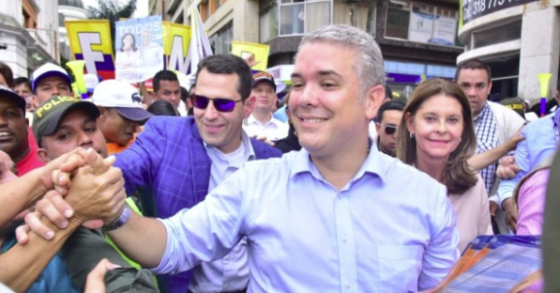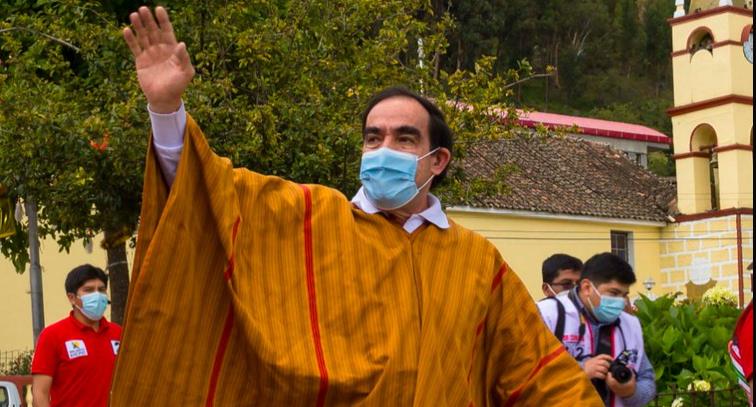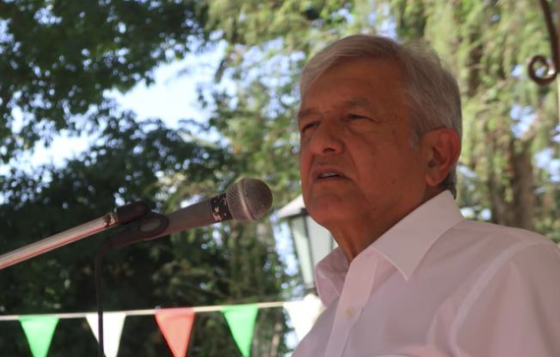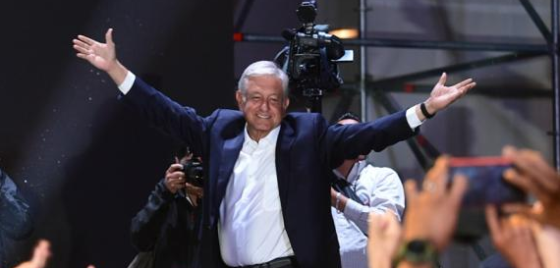
Will Colombia’s New President Deliver on His Promises?
Iván Duque, a conservative former senator, on Sunday won Colombia’s presidential runoff election. What does it mean for the country?
A Daily Publication of The Dialogue
Support for Peruvian presidential candidate George Forsyth dropped nearly six percentage points over the past month amid controversy regarding the validity of his candidacy, and candidate Yonhy Lescano gained traction, La Tercera reported in February, citing recent polls. How is Peru’s presidential election shaping up, and who are the candidates to watch? What are the most important factors driving voter support? To what extent are recent political crises, including lawmakers’ controversial ouster of former President Martín Vizcarra last November, and a highly fragmented Congress playing a role in the race?
Ursula Indacochea, director of the judicial independence program at the Due Process of Law Foundation (DPLF): “Peru’s upcoming presidential election is full of uncertainty, and its outcome is difficult to predict. According to recent polls, 30 percent of voters remain undecided, and the favorite candidate, Yonhy Lescano of the Acción Popular party, has only 11 percent support. Since Fujimori’s departure in 2000, Peruvians have preferred centrist, right-leaning rulers, as they have been fearful of losing the economic growth gained in the 1990s. Today, amid the pandemic, preferences seem to be oriented by two clear factors: vaccine management and job growth. Behind Lescano, who has a leftist agenda and supports a new constitution, three candidates are tied at around 8 percent—Verónika Mendoza (also a leftist with a progressive rights agenda), George Forsyth (who has been losing support and who seeks to be an alternative to traditional politics) and Keiko Fujimori (the daughter of the former president and who is running for a third time). In fifth place is the right-wing ultra-conservative Rafael López Aliaga, the self-proclaimed ‘Peruvian Bolsonaro,’ who is rising vertiginously, and who has managed to take the business sector’s support away from Fujimori, who is worn out and accused of corruption. Last November’s political crisis and the recent ‘vacunagate’ scandal do not seem to have affected the sectors that removed Vizcarra. The former president’s popularity seems intact, as he is a favorite candidate for Congress. The undecided 30 percent of voters will dictate the results.”
Julio Carrión, associate chair of the Department of Political Science and International Relations at the University of Delaware: “Predictably for Peru, the campaign is proceeding in unpredictable fashion. In November, massive public disapproval of Congress’ decision, which Manuel Merino spearheaded, to remove Martín Vizcarra forced Merino to resign as interim president. This led many to believe that Merino’s party, Acción Popular (AP), had no chance in the upcoming elections. And yet, Yonhy Lescano, also of AP, seems to be the favorite to secure a place in the likely runoff, and his party is also leading congressional preferences. Lescano articulates a message that mixes economic populism, calls for a more interventionist state and a promise to draft a new constitution. Given that he is not an outsider (he was a member of Congress from 2001 to 2019) and is leader of a traditional centrist party, his proposals do not seem to alarm those who place themselves in the center-right of the ideological spectrum and has the added virtue of attracting some leftists. This is evidenced in the most recent IEP poll: 71 percent of Lescano’s supporters self-identify with the center or the right, but more than a quarter (26 percent) self-identify with the left. The big unknown is who will confront him in the runoff. The race is very unsettled, since almost a third of those that IEP interviewed named no preferred candidate. Three scenarios are possible: one is Lescano confronting Verónika Mendoza, the candidate of the left, who almost qualified for the runoff in 2016. The second is Lescano facing the candidate of the conservative right, either Keiko Fujimori or Rafael López Aliaga (who are ferociously competing for the spot). The third scenario is Lescano opposing the generic, idea-free candidacy of George Forsyth. The next polls will tell us if Forsyth’s candidacy collapses and where his voters migrate. That will provide greater clarity to a race that is still unfocused.”
Cynthia McClintock, professor of political science and international affairs at The George Washington University: “There is a significant risk that Peru’s election will not have broad legitimacy and that governance will remain extremely daunting. Peruvians are focused not on the election, but rather on the still-raging pandemic and ‘vaccinegate’ scandal (in which ‘extra’ doses of the Sinopharm vaccine were secretly given to then-President Martín Vizcarra and more than 400 well-connected people, including the two ministers leading the negotiations with Sinopharm). Politicians’ credibility is at a new nadir. Cynical and fearing Covid-19, many poll monitors and voters will stay home on election day. Currently, none of the 18 candidates has even 15 percent in the polls; after the April 11 first round, the two finalists might be outliers who will struggle to gain majority support. For months, George Forsyth, a former star soccer goalie and mayor of a Lima district, led the polls; while young, he was a centrist and broadly palatable. If he remains disqualified due to the omission of some financial information from his registration forms, it will be the second time in two consecutive presidential elections that a candidate with an excellent chance to win is disqualified on minor grounds. Now, the front-runner is Yonhy Lescano, a longtime legislator from Puno who represents the left sector of the center-right Acción Popular (founded by former President Fernando Belaúnde). Although Acción Popular was hurt by the disastrous six-day government of its legislator Manuel Merino after Vizcarra’s impeachment, these misdeeds are less damning amid ‘vaccinegate.’ Close behind is Verónika Mendoza of the leftist Juntos por el Perú coalition; a 2011-2016 legislator from Cuzco, she finished third in the 2016 election. Gaining strength is Rafael López Aliaga, a rightist businessman and member of Opus Dei, who is widely perceived to be in the mold of Donald Trump.”
Nicolás Urrutia, associate director at Control Risks: “Presidential elections in Peru are notoriously difficult to predict, and it is very likely that we will see new front-runners in the coming weeks. The April 11 vote is most likely to result in a runoff election in June, which will prolong political uncertainty for businesses. Yonhy Lescano and Verónika Mendoza are the candidates who cause the most concern among the business community, as an electoral victory by either would likely result in a significant departure from Peru’s economic orthodoxy. Anti-corruption sentiment continues to run deep in Peru, but the electorate has changed its views on what type of candidate embodies the anti-corruption drive. Until recently, that sentiment seemed most compatible with the center-right, technocratic style of former President Martín Vizcarra, which helped position candidates such as George Forsyth. However, Vizcarra’s fall from grace after the ‘vacunagate’ scandal, among others, has fueled a shift that has benefited candidates on the left of the political spectrum, most notably Mendoza. Successive political crises have further undermined the public’s trust in ‘traditional’ parties and their leading figures and pushed voters toward new(er) faces. Forsyth and Mendoza, despite their deep ideological differences, are both relative newcomers to the political sphere. Neither is a complete ‘outsider,’ as has been the case in other countries, but both can present themselves as fresh faces.”
Rosa Alayza, associate professor at Pontificia Universidad Católica de Perú: “There are 20 candidates, most of whom are little known, and only the first has double-digit support. There is a great dispersion of the vote. This is a manifestation of political parties’ crisis of political representation, which dates back to the 1990s. Around 55 percent of voters have not yet decided on a candidate. That percentage is slightly higher than in past elections. Many will decide who they will vote for while lining up at the polls. But 89 percent of voters said they would cast a ballot. The leading candidates are: Lescano (with 11.3 percent support), followed by Mendoza (8.9 percent), both of whom have radical rhetoric. Mendoza is a leftist. Both give prominence to the state in productive sectors (mining and small agriculture, respectively) and seek to favor low-income sectors. In third place, two candidates are tied with 8.1 percent—centrist Forsyth, a former soccer player and mayor of the populous La Victoria district, appeals to the youth, and Fujimori, who proposes a ‘strong hand’ to guarantee the safety of the people. In fourth place is López Aliaga, with 7.6 percent, a conservative candidate with support from powerful sectors and linked to traditional religious groups. These candidates criticize the state for corruption and mismanagement. The former is linked to major graft scandals of infrastructure works with Odebrecht that included officials and even presidents. Criticism of the mismanagement is explained by the historical weakness of the state in managing public health services as well as the low quality and scope of education, and recently, its difficulties in facing the pandemic.”
Alfredo Torres, president of Ipsos Perú: “The outcome of Peru’s elections is more uncertain than ever. According to the most recent polls, there are five candidates with support of between 7 percent and 12 percent, and the most likely result of the April 11 election is that the election will go to a runoff. At the moment, the favorite is Yonhy Lescano, an experienced congressman from the center-left section of the Acción Popular party, which was founded by former President Fernando Belaúnde. The other eligible candidates are George Forsyth, a former soccer player and center-right mayor; Verónika Mendoza, a sociologist from Cuzco and admirer of Fidel Castro and Hugo Chávez; Keiko Fujimori, a former congresswoman and daughter of former President Alberto Fujimori; and Rafael López Aliaga, a conservative businessman and admirer of Trump and Bolsonaro. The scenario could become even more complicated if the National Jury of Elections decides to withdraw either Forsyth or López Aliaga from the race. Both are accused of having violated strict Peruvian law. Both of them were removed from the race, a move that each of them appealed to a higher court. The court’s decision must be made by March 11. Forsyth’s withdrawal could favor Lescano, and López Aliaga’s withdrawal could favor Fujimori. The next president of Peru will be the one who reaches the runoff with the lowest disapproval rating. For now, that’s Lescano and Forsyth, and Fujimori has the highest disapproval. The only sure thing about the next Peruvian election is that a very fragmented Congress will be elected. Most likely, seven or eight political parties will reach representation, and none will have a majority. The next president will have to form alliances with at least two parties in addition to his or her own to ensure governability.”
 The Latin America Advisor features Q&A from leaders in politics, economics, and finance every business day. It is available to members of the Dialogue’s Corporate Program and others by subscription.
The Latin America Advisor features Q&A from leaders in politics, economics, and finance every business day. It is available to members of the Dialogue’s Corporate Program and others by subscription.
Iván Duque, a conservative former senator, on Sunday won Colombia’s presidential runoff election. What does it mean for the country?
Mexicans go to the polls on Sunday, July 1, for the country’s presidential, legislative and local elections. What can we expect?
Leftist Andrés Manuel López Obrador swept to victory Sunday in Mexico. What changes are in store?
 Among the front-runners ahead of Peru’s April 11 presidential election is Yonhy Lescano of the
Popular Action party. // File Photo: Lescano Campaign.
Among the front-runners ahead of Peru’s April 11 presidential election is Yonhy Lescano of the
Popular Action party. // File Photo: Lescano Campaign.

